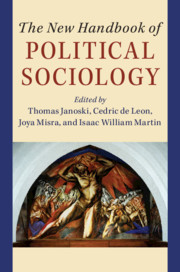Book contents
- The New Handbook of Political Sociology
- The New Handbook of Political Sociology
- Copyright page
- Dedication
- Contents
- Tables
- Figures
- Contributors
- Acknowledgments
- Introduction
- I Theories of Political Sociology
- II Media Explosion, Knowledge as Power, and Demographic Reversals
- III The State and Its Political Organizations
- 15 The Political Economy of the Capitalist State
- 16 States as Institutions
- 17 Nation-State Formation
- 18 The Political Sociology of Public Finance and the Fiscal Sociology of Politics
- 19 Politics, Institutions, and the Carceral State
- 20 The Political Sociology of Democracy
- 21 Revolutions against the State
- IV Civil Society: The Roots and Processes of Political Action
- V Established and New State Policies and Innovations
- VI Globalization and New and Bigger Sources of Power and Resistance
- Index
- References
20 - The Political Sociology of Democracy
From Measurement to Rights
from III - The State and Its Political Organizations
Published online by Cambridge University Press: 22 February 2020
- The New Handbook of Political Sociology
- The New Handbook of Political Sociology
- Copyright page
- Dedication
- Contents
- Tables
- Figures
- Contributors
- Acknowledgments
- Introduction
- I Theories of Political Sociology
- II Media Explosion, Knowledge as Power, and Demographic Reversals
- III The State and Its Political Organizations
- 15 The Political Economy of the Capitalist State
- 16 States as Institutions
- 17 Nation-State Formation
- 18 The Political Sociology of Public Finance and the Fiscal Sociology of Politics
- 19 Politics, Institutions, and the Carceral State
- 20 The Political Sociology of Democracy
- 21 Revolutions against the State
- IV Civil Society: The Roots and Processes of Political Action
- V Established and New State Policies and Innovations
- VI Globalization and New and Bigger Sources of Power and Resistance
- Index
- References
Summary
What is the political sociology of democratization? Political scientists and sociologists alike have long theorized about democratic transitions, though their focus has changed significantly over time. Although early models of democracy and democratization were largely based upon the experiences of today’s advanced industrialized nations, more recent frameworks offer an updated paradigm to account for the circumstances late democratizers face. Factors that were once considered irrelevant to democratization are now deemed part and parcel of the literature, including issues of power, inequality, history, state capacity, and globalization. A political sociology of democratization, then, is the study of the inherently political process of regime change that employs a sociological analysis of the circumstances and actors that surround and shape transitions, such as those mentioned above.
- Type
- Chapter
- Information
- The New Handbook of Political Sociology , pp. 538 - 563Publisher: Cambridge University PressPrint publication year: 2020
References
- 2
- Cited by

